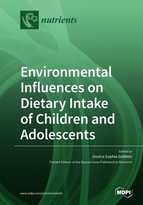Environmental Influences on Dietary Intake of Children and Adolescents
A special issue of Nutrients (ISSN 2072-6643). This special issue belongs to the section "Nutrition and Public Health".
Deadline for manuscript submissions: closed (31 December 2019) | Viewed by 119813
Special Issue Editor
Special Issue Information
Dear Colleagues,
Childhood is a crucial period for establishing lifelong healthy nutritional habits. The environment has an important influence on children’s dietary intake. Within the socio-cultural environment, parents, grandparents, peers, siblings, teachers, and others are important, for instance, by modelling behavior, implementing rules, or expressing certain norms. In addition to such interpersonal influences, higher-level influences are also important. These include the influence that social media and marketing of unhealthy foods have on today’s youngsters. Within the physical environment, the availability of healthy and unhealthy foods at home, school, and food outlets in the neighbourhood, among others, are essential. At the same time, the costs of healthy and unhealthy foods are of undeniable importance. Policies regarding these factors can set environmental changes into motion and ensure their long-term maintenance.
The current Special Issue focuses on the influence of environmental factors (socio-cultural, physical, political, and/or economic) on the dietary intake of children and adolescents (0–18 years of age) within any setting (e.g., home, child-care, school, neighbourhood) or environmental level. Topics of interest include, but are not limited to, those described above. All types of quantitative (both observational and intervention studies) and qualitative studies are welcomed.
Dr. Jessica S. Gubbels
Guest Editor
Manuscript Submission Information
Manuscripts should be submitted online at www.mdpi.com by registering and logging in to this website. Once you are registered, click here to go to the submission form. Manuscripts can be submitted until the deadline. All submissions that pass pre-check are peer-reviewed. Accepted papers will be published continuously in the journal (as soon as accepted) and will be listed together on the special issue website. Research articles, review articles as well as short communications are invited. For planned papers, a title and short abstract (about 100 words) can be sent to the Editorial Office for announcement on this website.
Submitted manuscripts should not have been published previously, nor be under consideration for publication elsewhere (except conference proceedings papers). All manuscripts are thoroughly refereed through a single-blind peer-review process. A guide for authors and other relevant information for submission of manuscripts is available on the Instructions for Authors page. Nutrients is an international peer-reviewed open access semimonthly journal published by MDPI.
Please visit the Instructions for Authors page before submitting a manuscript. The Article Processing Charge (APC) for publication in this open access journal is 2900 CHF (Swiss Francs). Submitted papers should be well formatted and use good English. Authors may use MDPI's English editing service prior to publication or during author revisions.
Keywords
- Children and adolescents
- Dietary intake
- Nutritional habits
- Environmental influences
- Social influences
- Availability, accessibility, and costs of food
- Nutrition-related policy







